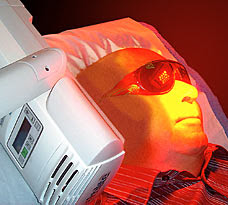Photodynamic Therapy to beat cancer
 Photodynamic Therapy (PDT), is a new procedure to remove skin tumors without the need for an anaesthetic or even a hospital stay.
Photodynamic Therapy (PDT), is a new procedure to remove skin tumors without the need for an anaesthetic or even a hospital stay.
PDT uses a class of drug which starts working only when activated by light. This then produces a damaging form of oxygen that destroys tissue.
For internal cancers, the drug is injected a few days before treatment. Once injected, the patient must be careful to avoid bright light, such as fluorescent light and sunlight, until treatment has taken place.
During treatment, a narrow beam of red light, usually from a laser, is shone onto the tumour, activating the drug and killing the malignant cells. It takes only a few minutes and the patient can go home immediately.
Patients describe a 'tingling' sensation as the light is applied, but this usually dissipates after half an hour.
The National Institute of Health and Clinical Excellence has recently approved PDT for the treatment of nonmelanoma skin tumours. 'There are no major safety concerns,' its guidelines state. 'Cosmetic outcomes...(are) good or excellent.'
For skin cancers, the drug is applied in the form of a cream. The patient is then bathed in laser light, but only the cream covered area reacts.
The main PDT research centre is at the National Medical Laser Centre in University College Hospital, London (UCH), where they are investigating other uses of the therapy. Essentially, it should work well anywhere inside the body where an endoscope - an examination tube carrying a light - can get to.
'Besides treating skin cancer, we've also seen more than 600 patients with tumours in the mouth and neck,' says Stephen Brown, professor of Laser Medicine and Surgery at UCH. 'It works best when the cancer isn't too far advanced.'
Light can also be taken down the esophagus - the tube from the throat to the stomach. Acid escaping from the stomach can damage cells that line the bottom of the esophagus, turning them pre-cancerous - a condition known as Barrett's esophagus.
A trial has found PDT is twice as effective in treating pre-cancerous cells in the esophagus as anti-acid drugs (a conventional treatment).
One of the main advantages of PDT is the lack of side-effects. While chemotherapy drugs have to be infused over weeks and often cause nausea, as well as damaging fast-growing cells (the reason why patients lose their hair) and the gut lining, PDT's side-effects are nearly always relatively mild and usually limited to some pain, swelling and nausea.
Furthermore, any surrounding healthy tissue that is damaged grows back in a matter of weeks. Healing is quick because, unlike radiotherapy, PDT doesn't damage the underlying collagen scaffolding of healthy cells, making repair much easier.
If pre-cancerous cells do reappear, PDT can be done twice more and then, if necessary, there is still the option of the operation.
'Sometimes PDT can be used to salvage the situation when surgery, chemo or radiation has failed,' says Professor Brown. 'But it makes much more sense to use it first.'
Yet despite its apparent benefits, PDT is still regarded with skepticism by conventional cancer experts. Cancer charity BACUP describes it as 'not yet established...still being tested', and warns about possible side-effects.
The history of the treatment is partly to blame. 'When it first appeared in the 1980s, various wild claims were made for it,' Brown says. 'I think some people are still distrustful because of that.'
Since then, however, the drugs and techniques have been refined and trials show its benefits.
Another possible reason for PDT's marginalization is that it requires a new approach. 'If you are a cancer surgeon or a radiologist, or you have a unit set up to do chemotherapy, you've got a huge investment in existing technology, and PDT doesn't use any of it,' says Bown.
'But we are not trying to put anyone out of business. The beauty of PDT is that it is simpler, cheaper and less invasive to begin with, but if it doesn't work, the more conventional techniques can also be used.'
Research is already underway at the UCL unit to add PDT to the list of options for prostate cancer. This is because of changing attitudes to treatment.
'In the past, as soon as cancer was detected, the advice was to remove the whole organ,' says Brown. 'That usually got rid of the cancer, but it often left the patient impotent or incontinent.
'Now the trend is to treat the main tumour but leave smaller ones and then monitor the patient carefully. PDT can be repeated if the cancer rears its head again.'
Removing a cancer with minimum surrounding damage is what makes PDT so effective. But there is a difference between using PDT on body surfaces and in the prostate, which is not accessible to an endoscope.
'You have to locate accurately the tumour, which you can't do with scans,' says Brown. 'So we may have to take up to 20 biopsies.' However, this is still only a research procedure.
There are only two or three other major centres researching PDT in the UK and while experts still differ on when PDT is appropriate, everyone agrees there should be more trials to test it.
More Info:



No comments:
Post a Comment